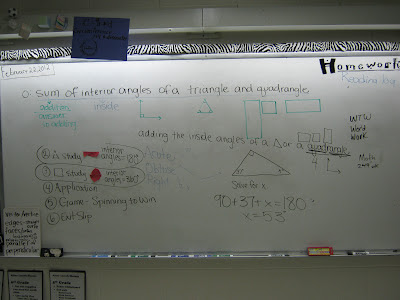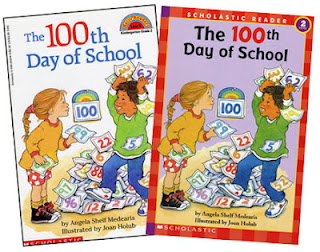I bought a soft-tip stylus to use on the Ipad, as my granddaughter practices writing her numbers ...instead of just using her finger. I have seen too many students form their numbers from the bottom up so I am working hard to see that she writes them with the correct sequence. This application makes it fun to practice and saves paper too :)
Tuesday, February 28, 2012
A Fun Way to Practice Writing Numbers
Sunday, February 26, 2012
Making Sense of Math for Second Language Learners
Thursday, February 23, 2012
When I read"..." I thought....because...
Look at this fabulous deep thinking instructional strategy from my friend Ginger. Ginger always finds a way to help her 3rd Grade students think deeper about their independent reading.
Deborah Devine
Deborah Devine
Friday, February 10, 2012
Common Core Standards Taught During Calendar Routine Activities
Here are the promised Calendar Cards to promote the Common Core Standard K.CC.5 that I am sharing with you. Just click HERE and Here to go to my Google Docs file to download them.
This is the Common Core Standard:
Count to answer "How many?" questions about as many as 20 things arranged in a line, a rectangular array, or a circle, or as many as 10 things in a scattered configuration.
How would I use them?
I would make a ringed set of laminated counting cards for each child in your class. Then, each day (they are numbered in the upper left hand corner of the card) the class would orally practice counting the hearts together. Then I would ask individual students about their strategy to count sets of objects when they are not lined up in a row (which is the easiest way for students to count objects).
The student would orally share their strategy. Lastly, I would call on one more individual student to try the strategy that was discussed by their classmate and orally recount the hearts of the day.
By doing this as a calendar routinue, the teacher is providing 31 opportunities for students to practice this Common Core Standard!
Deborah Devine
Wednesday, February 8, 2012
Everyday Math Training on February 17th, 2012
Are all my U-46 District friends ready for the first OFFICIAL training on the 2012 Common Core Edition of Everyday Math? Half of your day will be a presentation on the Mathematics Common Core, and the other half will be provided from Everyday Math Trainers that are being flown in from
all over the country...yeap...South Dakota, Oregon, and California to name just a few.
I've been working hard on my session for part of the Kindergarten level training. I'm going to show (not just tell) how the calendar routine might look for the whole year. I've been creating 9 display boards to show how the routines might change as your students are ready for new learning during the school year.
I know that my display boards won't be as "cute" as some calendar boards as I've seen in your classrooms... but it has a definite "mathematics look." I've designed some Common Core display sheets for your daily calendar like the one below in English and Spanish to add to the provided Everyday Math suggestions too.
For all my FRIENDS OUTSIDE OF U-46....I'll be sharing later with you too. I hope you will find the displays interesting too.
Deborah Devine
all over the country...yeap...South Dakota, Oregon, and California to name just a few.
I've been working hard on my session for part of the Kindergarten level training. I'm going to show (not just tell) how the calendar routine might look for the whole year. I've been creating 9 display boards to show how the routines might change as your students are ready for new learning during the school year.
I know that my display boards won't be as "cute" as some calendar boards as I've seen in your classrooms... but it has a definite "mathematics look." I've designed some Common Core display sheets for your daily calendar like the one below in English and Spanish to add to the provided Everyday Math suggestions too.
| Common Core K.CC.2 Know number names and the count sequence beginning from a given number within the known sequence (instead of having to begin at 1). |
Deborah Devine
Monday, February 6, 2012
100th Day Ideas
Need ideas for your 100th day celebration? Joan Holub, the illustrator of "The 100th Day of School" has a list of 300 ideas on her website. Here is the address: http://www.joanholub.com/100thDay.html
Some of the ideas that I liked are:
What activities do you like to do on this day? Remember what Mary Poppins taught us, "That a spoonful of sugar makes the medicine go down in the most delightful way."
...and "An element of fun makes learning go down in the most delightful way too!"
Deborah Devine
Some of the ideas that I liked are:
- Writing "100 Reasons We Like School"
- Estimation: Which of the 3 jars contains 100 small items? One with exactly 100, one with 10 more than 100, one with 10 less than 100. Each jar should have the same item such as candy corn, popcorn, small marshmallows. Label each jar Jar A, Jar B, Jar C.
- Build a structure with 100 small brightly colored cups
- Drawing a picture of what the child will look like "When I am 100 years old."
- Count 100 objects from our math center. (unifix cubes, pattern blocks, shells, caps, etc.) by making 10 piles of 10. Then the 100 objects are placed in a plastic bag. When everyone is finished we gather around the balance scale and estimate if 100 pattern blocks will weigh more/less than 100 cubes. Select one object to remain constant and weigh everything against that constant.
- Complete and illustrate the following sentence frame: I could eat 100 _____but I could never eat 100 ______. For example: I could eat 100 chocolate chips, but I could never eat 100 chocolate chip cookies.
- Our class went outside in the snow and made 100 snowballs. (Which are usually strictly forbidden!) Before we made the snowballs the children figured out how many snowballs each of us would have to make. We brought the snowballs inside and let them melt after we predicted how much water would result from the snowballs melting using various size jars that we had been using for other estimating activities.
- Having a family 100 Day Night, with the room set up with centers. One of the centers is to draw your family on blank paper doll cutouts. Then they had a bulletin board titled: 100 People We Know. They said the students loved finding their families on the board.
What activities do you like to do on this day? Remember what Mary Poppins taught us, "That a spoonful of sugar makes the medicine go down in the most delightful way."
...and "An element of fun makes learning go down in the most delightful way too!"
Deborah Devine
Saturday, February 4, 2012
Higher or Lower Decimals Game: Comparing the value of decimals
This math game, "Higher or Lower Decimals," requires students to compare the value of decimals. A decimal card is chosen by one player, and the other players are trying to determine the value of the card by naming a decimal value and then receiving a clue of HIGHER or LOWER from the player who drew the card. The response sheet lists the decimal values that are possible to choose.
Player One, who is choosing the decimal card, must understand it's value in relationship to the amount named by the other players in the game. The players who are guessing possible values need to understand the values and be able to compare them in order to apply the clues of "higher or lower" given by Player One.
So you can see that this simple game requires a lot of thinking and comparing of decimal values.
Click here to obtain a copy of the response sheet for "Higher or Lower Decimals."
Deborah
Player One, who is choosing the decimal card, must understand it's value in relationship to the amount named by the other players in the game. The players who are guessing possible values need to understand the values and be able to compare them in order to apply the clues of "higher or lower" given by Player One.
So you can see that this simple game requires a lot of thinking and comparing of decimal values.
Click here to obtain a copy of the response sheet for "Higher or Lower Decimals."
Deborah
Friday, February 3, 2012
Extended Response
To answer the question: "Deborah, how would you teach students to write an extended response to communicate their thinking in the area of mathematics?"
Subscribe to:
Posts
(
Atom
)










